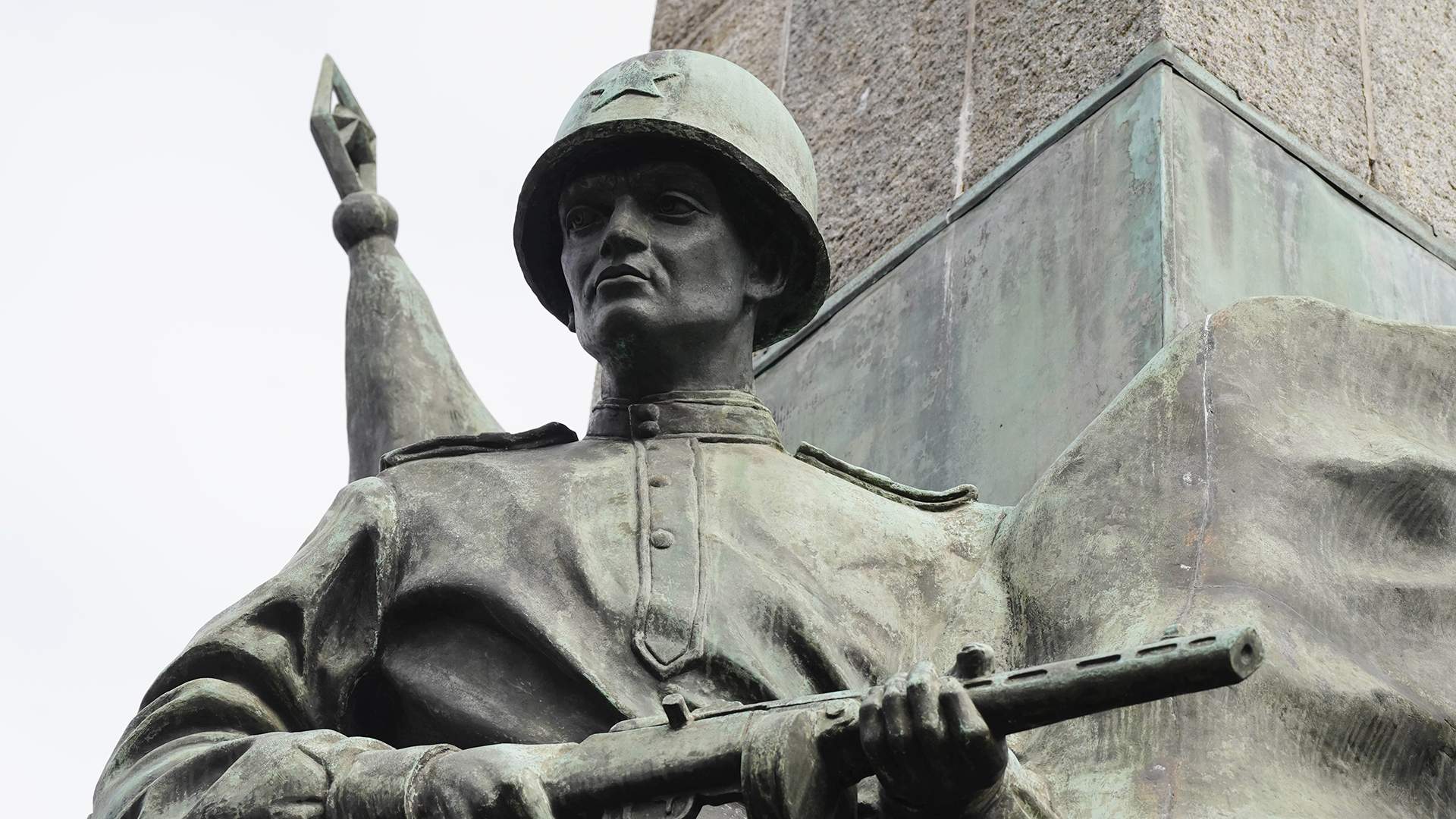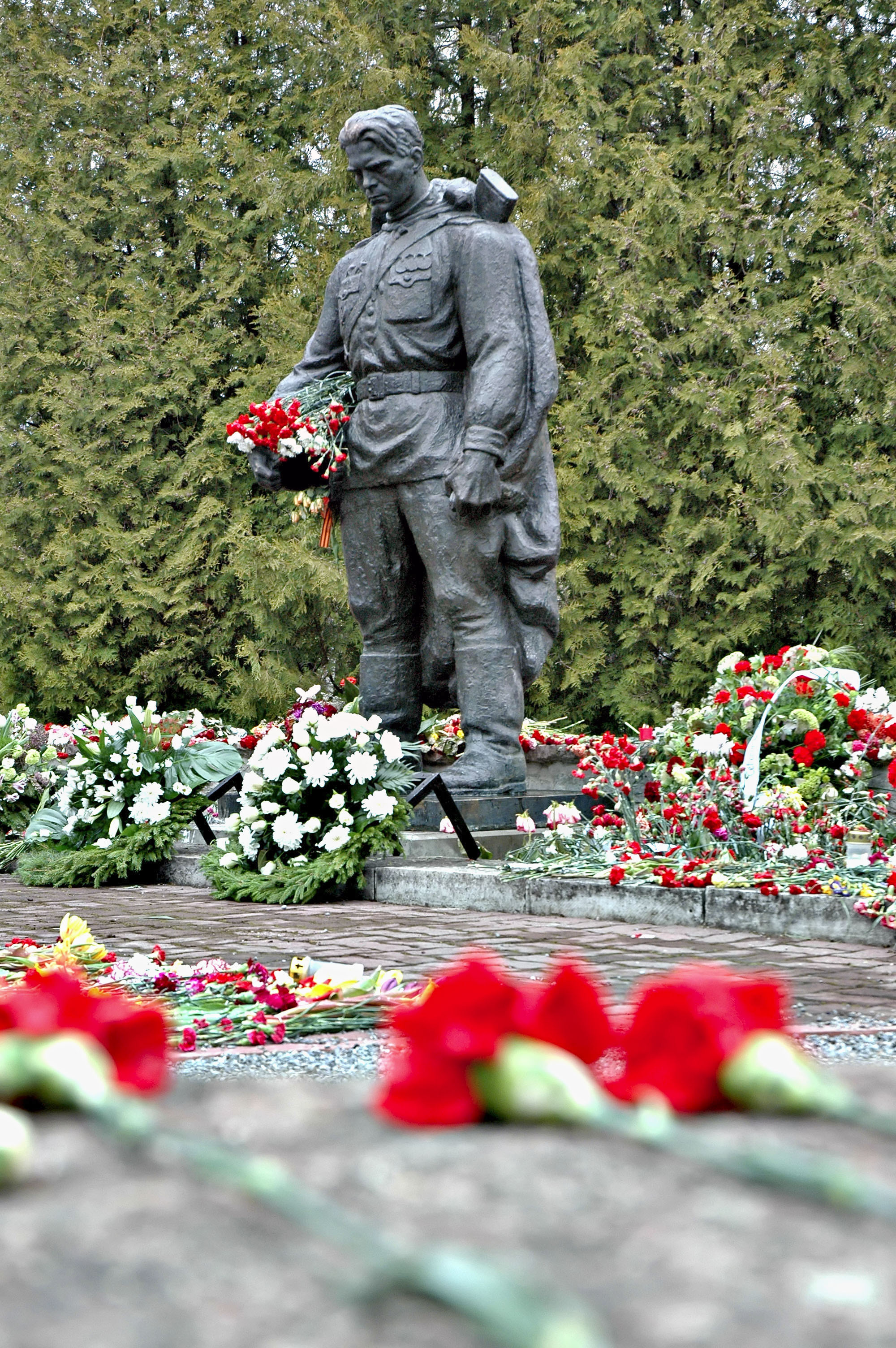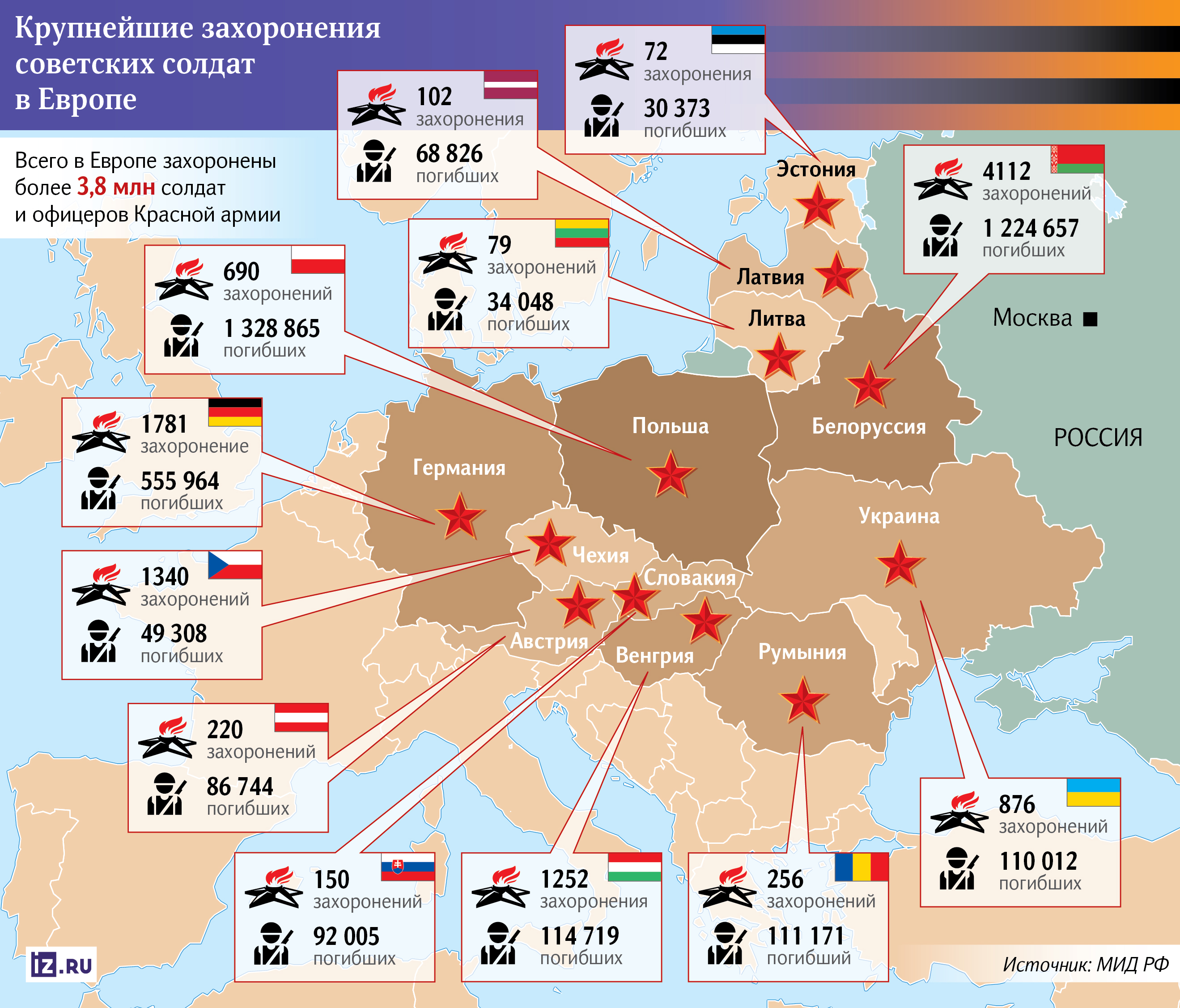Vandal history: at least 300 Soviet monuments were demolished in the EU in three years

At least 300 cases of the dismantling of monuments to Soviet soldiers in the European Union have been recorded since 2022, Izvestia found out. At the same time, since the early 1990s, more than 3.5 thousand cases of destruction of such memorials have been reported abroad. The Russian Foreign Ministry told Izvestia that over 3.8 million Soviet soldiers are buried in Europe, and there are more than 11.5 thousand graves in total. Most of them are in Belarus, Poland, Germany, Hungary and Ukraine. About how historical memory is treated in individual countries — in the material of Izvestia.
Attitudes towards Soviet monuments in Eastern Europe
More than 3.8 million Soviet soldiers are buried in Europe, and there are more than 11.5 thousand graves in total, the Russian Foreign Ministry told Izvestia. At the same time, over the past three years, the Moscow Bureau for Human Rights has recorded at least 300 cases of the dismantling of monuments to fallen soldiers in EU countries. Alexander Brod, director of the organization and member of the Human Rights Council under the President of the Russian Federation, told Izvestia about this.
"Since the early 1990s, there have been more than 3.5 thousand cases of the dismantling of monuments to Soviet soldiers abroad," he said. — As of the end of April, there were more than 100 cases of vandalism against monuments to fallen soldiers. The largest number of such cases occurred in Poland and Lithuania.
The Baltic republics suffered greatly from the Nazi occupation during the Great Patriotic War. At the cost of enormous efforts and sacrifices, the Red Army managed to squeeze the enemy out of these territories. Its total losses in the 1944 Baltic operation amounted to 280 thousand people, of which about 60 thousand were killed. According to the Russian Foreign Ministry, provided to Izvestia, there are more than 250 military graves in the Baltic States. Most of them are in Latvia (102). About 68.8 thousand Red Army soldiers are also buried there. Lithuania is next, with 34,000 soldiers buried there.
The radical transformation of national identity and the rewriting of history began in the Baltic States back in the 1990s. The laws adopted as part of the decommunization policy not only consolidated the mythology of the "victims of the Soviet regime" in the official discourse, but also rehabilitated the collaborators and the "forest brothers."
In recent years, the struggle with the past in the Baltic States has only intensified. So, in 2022, the Estonian authorities announced the start of a large-scale campaign to dismantle Soviet military monuments and reburial the remains of soldiers. A working group under the Government of the Republic then recommended demolishing or replacing 244 of the 322 sites, 213 of which are a combination of military graves and monuments. In 2023, the Government allocated €1.42 million to the Ministry of Defense for the dismantling of Soviet memorials. In early April, the Russian Embassy reported that employees of the Estonian Military Museum had destroyed monuments in memory of Red Army soldiers at the Tallinn military Cemetery. By the way, according to the Russian Foreign Ministry, about 30.3 thousand Soviet soldiers are buried in Estonia.

The situation is similar in neighboring Poland. 600 thousand soldiers gave their lives for the liberation of this land from the Nazis. According to the Russian Foreign Ministry, there are 690 graves in the country, in which over 1.3 million soldiers (about a third of all Soviet soldiers buried in Europe) are buried. Back in 2017, an updated law on decommunization came into force in Poland, which provides for the demolition of monuments and memorials paying "tribute to the memory of persons, organizations, events or dates symbolizing communism or another totalitarian system." At the end of 2023, Andrei Taranov, acting director of the Russian Ministry of Defense's department for perpetuating the memory of those who died defending the Fatherland, said that 468 of 561 monuments to Soviet soldiers had been demolished in Poland.
In the Czech Republic, which also condemns the Soviet period and belittles the role of the Red Army in the liberation of Europe, 28 of the 665 monuments were dismantled by the end of 2023, Andrei Taranov reported. The most high-profile case was the demolition of the monument to Marshal Ivan Konev in 2020. At the same time, as previously reported by the Russian Ambassador to the country, Alexander Zmeevsky, the Czech authorities do not provide the Russian side with information about the exact location of the monument. According to the Russian Foreign Ministry, about 49.3 thousand Soviet soldiers are buried in the Czech Republic. There are 1,340 graves in total.

However, the practice of demolishing Soviet monuments is not considered the norm in all Eastern European countries. For example, in Hungary and Slovakia, where they also treat the Soviet past ambiguously and separate acts of vandalism occur, monuments from the period of the Great Patriotic War are periodically restored. For example, in September 2022, a Soviet burial site in the Hungarian town of Dunafeldvar was repaired. This was done with the assistance of the local mayor's office. In addition, last month in the city of Szeged, after extensive restoration, the largest memorial complex in the eastern part of Hungary dedicated to the memory of Soviet soldiers was opened.
As for Slovakia, on May 6, Prime Minister Robert Fico promised to assist in the reconstruction of monuments erected in the republic in honor of the soldiers of the Red Army. At the same time, the Slovak politician is the only leader from the EU countries who plans to come to Moscow for the celebration on May 9th. In Slovakia, according to the Russian Foreign Ministry, there are about 150 graves containing more than 92,000 Soviet soldiers.
Attitudes towards monuments in Ukraine, Moldova and Belarus
According to the Russian Foreign Ministry, 1.2 million Soviet soldiers are buried in Belarus. Today, there are about 9,000 monuments and graves of the Great Patriotic War in this country. During her years, every fourth person died here, and the memory of the bloody war is revered in the country. The Brest Hero Fortress is considered to be one of the most significant complexes. May 9th is always celebrated on a large scale in the republic. There are parades, concerts and fireworks in the country.
However, the attitude towards the memory of the Great Patriotic War differs significantly in neighboring countries — in Moldova and Ukraine. According to estimates by the Russian Foreign Ministry, about 5,600 soldiers are buried in Moldova. In Ukraine, the figure is much higher — 110 thousand. After the coup in Ukraine in 2014, an active struggle began in the country against monuments that are somehow connected with Soviet history. Later, the law "On the condemnation of the Communist and National Socialist totalitarian regimes" was adopted. After its adoption, the dismantling of memorials and monuments associated with the USSR began. In the period from 2014 to 2022, more than 2.5 thousand monuments were dismantled in Ukraine.
Since February 2022, the Kiev regime has been particularly active in fighting everything related to the USSR. In the last calendar year alone, dozens of cases of monument relocation have been registered in Ukraine. So, in the Vinnytsia region, tombstones were demolished from the graves of the heroes of the Great Patriotic War, after which they were transported to the place where Hitler's headquarters "Werewolf" was located near Vinnytsia during the Nazi occupation. In December last year, the golden stars of Moscow and Minsk and their letter names were chipped from the Alley of Hero Cities at the Museum of the History of Ukraine in Kiev. In November last year, it was reported about the demolition of the monument to the Soviet intelligence officer Zoya Kosmodemyanskaya in the city of Belgorod-Dnestrovsky in the Odessa region. At the end of April, it became known that the Lviv authorities began to dismantle monuments and fences of the graves of Red Army soldiers located on the territory of the memorial complex "Hill of Glory".
The Moldovan authorities are also moving away from the common history with the Russian Federation. For example, in 2024, unknown persons dismantled a monument from a mass grave of Soviet soldiers. Later it was reported that the Government of the republic has prepared amendments to laws that will simplify the demolition of monuments.
Attitudes towards Soviet graves in Old Europe
The Eastern European narratives of the "Soviet occupation", which are mostly characteristic of the Baltic States, Poland (and now Ukraine), are gradually increasing their influence in the countries of Western, Northern and Southern Europe. A clear proof of this is the European Parliament resolution "On the importance of preserving historical memory for the future of Europe", adopted in September 2019. Six years ago, 535 deputies voted for the document, and it was developed by the largest factions of the EP. In the resolution, European politicians blamed the outbreak of World War II not only on Nazi Germany, but also on the USSR. In addition, the document claimed that the Nazi and Communist regimes "carried out mass killings, genocides and deportations," and their actions during the 20th century caused damage to human freedoms and lives on an "unprecedented historical scale."
"You can anathematize Stalinism and totalitarianism in general in any way you want, and in some ways these will be well-deserved reproaches, of course. <...> But equating the Soviet Union or putting the Soviet Union and nazi Germany on the same level is the height of cynicism," President Vladimir Putin commented on the resolution in 2019.
For obvious reasons, there are far fewer Soviet military graves in old Europe than in Eastern Europe. Most of the sites are located in Germany (1781), Austria (220), Belgium (69), France (51). In these countries, where tens of thousands of Soviet soldiers are also buried, there are no laws on decommunization, such as in the Baltic States or Poland. The Western European States are mostly characterized by isolated cases of vandalism. For example, Russian Ambassador to Germany Sergey Nechaev said in an interview with Izvestia that the Russian Federation has recorded 21 such episodes since 2024. Moscow recognizes that the German side is generally fulfilling its obligations under the intergovernmental agreement on the care of military graves of 1992 in good faith.
— In most cases, the maintenance and maintenance [of monuments] are carried out very carefully. I can say this, in particular, about Potsdam and its surroundings," Bernd Muck, head of the Brandenburg Friendship Society, told Izvestia. "The overwhelming majority of the population [in Germany] condemns vandalism.
The situation in the Nordic countries is ambiguous, in particular in Finland, which is located next to the Russian Federation. In 2022, Helsinki abruptly changed its policy towards Moscow against the background of joining NATO, which could probably affect the attitude of society towards the history associated with the USSR. According to the Russian Foreign Ministry, 122 Soviet military graves are located in the country. The Russian Embassy in Helsinki recently announced that cases of vandalism at Soviet war memorials have become more frequent in Finland. According to diplomats, these are mostly relatively minor injuries, in particular, the application of inscriptions and drawings in paint. In most cases, the memorials were restored by the embassy with the help of caring compatriots.
On the eve of Victory Day, Izvestia has prepared a special project "Two Worlds. One War", dedicated to the history of the confrontation between the USSR and Germany from the mid-30s to the mid-40s of the last century.
Переведено сервисом «Яндекс Переводчик»






